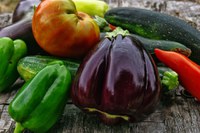Prairie Fare: Stint as a Student Chef Prompts Me to Keep My Day Job
(Click an image below to view a high-resolution image that can be downloaded)
By Julie Garden-Robinson, Food and Nutrition Specialist
NDSU Extension
“Zucchini are easier to slice if you cut them from top to bottom,” the student chef said to me.
I cut the zucchini as described.
I was enjoying a culinary workshop on Spanish and Mediterranean-inspired foods one afternoon at a conference out of state.
“You were supposed to cut the zucchini on the bias,” the chef instructor said as he examined my work.
The recipe said to ask the chef for instructions. I asked the wrong chef.
“I didn’t tell her to do that,” the student chef said.
“Yes, you did,” I thought to myself. He probably was being graded.
I wasn’t about to argue. With his chef’s toque (hat), the instructor must have been 7 feet tall. If I were being graded, I was below the curve at this point.
I conversed with the instructor after getting a new zucchini, which I cut in slanted strips (on the bias) and then tossed with olive oil in a large bowl. I had redeemed myself, I thought.
“I will demonstrate how to grill eggplant properly,” he said to me.
Soon I was cutting the shiny purple-skinned eggplants into thin slabs on the bias and tossing them in a little olive oil. Cutting them like this exposes more surface area for flavor development.
“You are cutting up a female eggplant,” he noted.
Oh, dear. I grinned, bit my lip and said nothing. I already have written a column about the fact that peppers and eggplants are not male or female.
I headed to the hot grill and laid the zucchini and eggplant on the grates. Did I mention the grill was really hot?
I was sharing the large grill with another workshop participant, who was grilling red peppers. The peppers caught on fire and were shooting up flames. The chef wandered over, grabbed some tongs and nonchalantly threw the burning peppers in a bowl and told her to start over.
I didn’t want my eggplant slabs to burn, so I flipped them.
“Why did you turn them already?” the chef asked. “We also want them to have criss-cross grill marks. You need to flip them from the 10 o’clock to the 2 o’clock position.”
I’m going to have to turn in my chef hat and apron, I thought to myself.
“Well, I flipped them because you abandoned me,” I said, laying on the guilt and giving him a bad time.
He laughed. “OK, I won’t abandon you again.”
I felt and looked like a roasted tomato after standing at the grill, cooking enough roasted vegetables for about three dozen people.
I tossed the grilled veggies with more olive oil, a splash of red wine vinegar and some coarse salt and black pepper. I placed the “good ones” with the criss-cross grill marks on top of the serving platter and garnished the tray with parsley.
The participants ate all of my grilled veggies, so I count that as success.
Eggplant has an interesting history. Besides grilling, eggplant can be roasted, fried, steamed or sauteed. Eggplant is high in water content and low in calories at just 18 calories per half-cup of cooked eggplant. It provides some fiber, vitamin C and iron. See https://tinyurl.com/NDSUGrilledVeggies for more information about grilling vegetables.
Eggplant history dates back to early China. However, when the eggplant made its way to Europe, Europeans gave it an unflattering nickname. The eggplant was called “mala insana,” which means the “apple of madness.”
According to food historians, the eggplant gained that unsavory name as a result of being in the nightshade family. Some nightshade plants are poisonous, and tomatoes also were shunned because they were believed to be deadly.
Eggplant, known as “aubergine” in France, is used in a variety of international cuisines, particularly Greek and Italian. Eggplant’s mild flavor and spongelike texture absorb the flavor of added ingredients, such as garlic, basil and oregano.
Have you tried “Eggplant Parmesan” at an Italian restaurant? How about “Babaganoush” or “Moussaka” at a Greek restaurant?
If any of these dishes sound appealing, pick up an eggplant and give it a try on your menu. When selecting an eggplant, choose one with shiny skin and no dark spots, which indicate decayed areas. Although the peeling can be eaten, more mature eggplant will have a tougher skin.
Try this recipe adapted from the Pennsylvania Nutrition Education Network. You can roast the peppers and eggplant in your oven, or you could try grilling them for extra flavor.
Mediterranean-inspired Eggplant and Red Bell Pepper Dip
1 medium eggplant
2 red bell peppers
1 small onion
1/4 tsp. garlic powder (or more if desired)
2 Tbsp. olive oil
1 tsp. oregano
1 tsp. basil
1/4 tsp. salt
Preheat oven to 400 F. Peel the eggplant; chop into 1-inch cubes. Chop the red peppers. Peel and chop the onion. Put all the ingredients in a large bowl and stir together. Spread the ingredients in a covered roasting pan. Bake for 40 to 45 minutes, stirring every 10 minutes, until the eggplant is lightly browned and soft. Let the roasted vegetables cool for 10 minutes. Place in a blender or food processor and blend until smooth. Serve the dip cold or at room temperature with whole-grain crackers or garlic toast rounds.
Makes eight servings. Each serving has 65 calories, 4 grams (g) fat, no protein, 7 g carbohydrate, 3 g fiber and 75 milligrams sodium.
(Julie Garden-Robinson, Ph.D., R.D., L.R.D., is a North Dakota State University Extension food and nutrition specialist and professor in the Department of Health, Nutrition and Exercise Sciences. Follow her on Twitter @jgardenrobinson)
NDSU Agriculture Communication - Oct. 4, 2018
| Source: | Julie Garden-Robinson, 701-231-7187, julie.garden-robinson@ndsu.edu |
|---|---|
| Editor: | Ellen Crawford, 701-231-5391, ellen.crawford@ndsu.edu |



